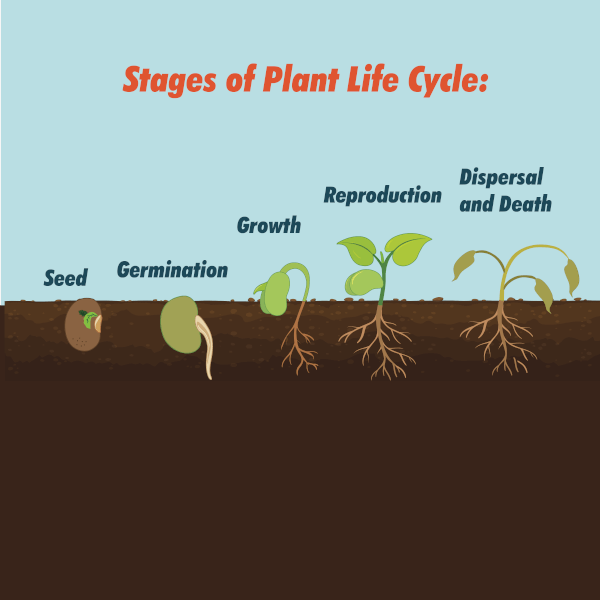In this article, we will study the life cycle of a plant for kids in a very easy language.
Just like human beings and animals, plants also have a life cycle.
It starts from birth until the end, which means the life cycle starts from the Seed and ends with the mature plant.
However, not all plants produce seeds. Some of the plants, like mosses, produce cells called Spores.
Now, let us understand the life cycle of a plant for kids in detail:
Six stages of plant life cycle
- Seed
- Germination
- Seedling
- Adult Plant
- Pollination
- Seed Dispersal
We will here discuss all the stages mentioned above one-by-one in detail:
Stage 1: Seed
The plant life cycle starts with the Seed. You have eaten the seeds of some plants like pumpkin and sunflower seeds. They are protected from the tough outside layer known as OUTER COAT.
Every essential element for the growth of a plant is present inside the Seed.
There is an EMBRYO, also called Tiny Baby Plant. The embryo contains the root, shoot, and the first true lives, which will become a plant later, and the ENDOSPERM, which provides nutrients to the embryo.
The Seed reaches its destination in different ways,
By spreading the Seed by wind, some animals eat the Seed and spread it through their waste also, some flying insects like bees and birds carry the Seed along with them and drop it anywhere.
Once the Seed reaches the destination, the second stage emerges:
Stage 2: Germination
For a seed to grow, there is a need for a perfect conditions like Temperature, Sunlight, moisture, and
oxygen; when all these four conditions meet, the Seed begins to sprout. The roots come from the coating and make their way into the soil. This process is called Germination.
Stage 3: Seedling
After the Germination, a small plant grows called a seedling. It comes out of the soil and starts growing towards the sunlight. Seedlings get nutrients from the soil through the roots and direct sunlight.
Chlorophyll(present on the leaves of the plant) uses sunlight, water, and carbon dioxide to produce energy for the plant, and the process is called PHOTOSYNTHESIS.
Stage 4: Adult Plant
The energy produced during photosynthesis helps the seedlings grow into mature(adult) plants.
The adult plant has roots, stems, and leaves.
The root extracts all the essential nutrients from the soil, which are carried out to the plant by stem. And the leaves help in making energy through the process of photosynthesis.
Here we discuss the life cycle of a flower for kids,
The mature plant produces flowers that ensure reproduction.
Different parts of a flower:
Petal: It is colorful and bright, attracting insects for pollination.
Stamen: This part of the flower produces pollen. Pollen is a powdery substance that contains half of the genetic material.
Stigma: This part of the flower receives the pollen; it contains the plant’s ovule. When the ovule gets fertilized by the pollen, it becomes Seed.
Stage 5: Pollination
The process in which the stigma of one plant receives pollen from the stamen of another plant. This process is carried out by many methods, by birds, flies, wind, and insects.
The petals(part of the flower) attract the insects. Insects drink the sweet liquid(nectar) produced by the flowering plant.
Pollen contains only half of the genetic material, and the rest half is contained by the ovule, located in the stigma.
When the pollen reaches the stigma, they get fertilized and becomes the Seed.
Step 6: Seed Dispersal
By fertilization, Seed is produced. Again the fertilized seeds are dispersed by the wind, flies, and insects; further, the process of reproduction takes place.
Frequently Asked Questions(FAQs)
What is the definition of a plant for children?
It is a living thing that grows out of the soil and turns sunlight into food through photosynthesis. A plant can be small or large.
What does a plant need to live?
Water, sunlight, nutrition, temperature, and space are the needs of a plant to live.
What is the life cycle of a plant for grade 1?
It includes five stages:
- Seed
- Germination
- Seedling
- Adult plant
- Pollination
How do the plants spread seeds?
There are many ways to spread the seeds, like wind, insects, and flies. Animals also carry Seed, and Seed comes out through their waste.
Why are bees attracted to flowers?
For reproduction, pollen needs to be carried from one plant to another. Bees play an important role in transporting the pollen to another plant.
The colorful and bright scent of petals makes the bees visit them.
- What is the kindergarten plant life cycle?
The same 5 plant life cycle stages take place here, which are
Seed, Germination, Seedling, Adult plant, and pollination.
Conclusion
We have discussed the complete life cycle of a plant for kids. Now you can answer the questions related to the life cycle of a plant and plant life cycle stages.
In short, we have discussed.
Seed, Germination, seedling, the adult plant, and pollination are the five stages of the life cycle of a plant. We have discussed them in a very detailed way.
Hope you understand and make your kid understand the simple process of the plant life cycle.
Here is a youtube reference video to understand easy:
Have a look,
Life cycle of a plant for kids:
















